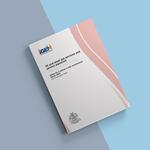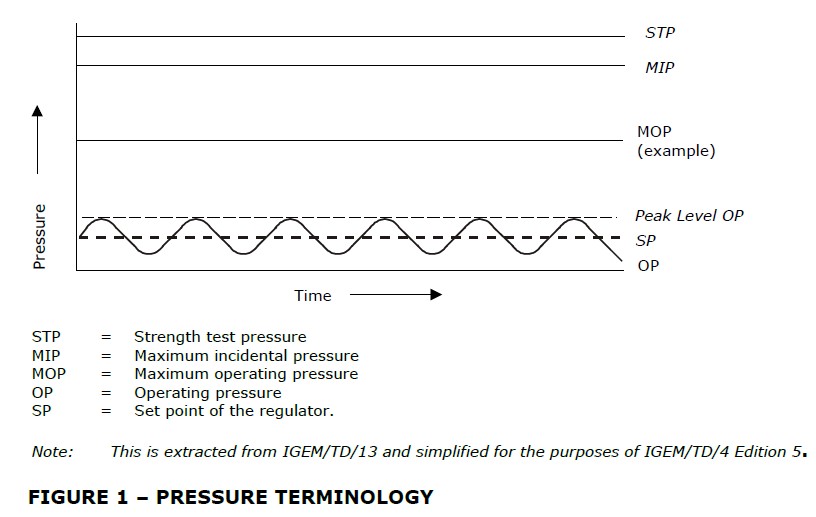IGEM/TD/4 Edition 5 - Polyethylene (PE) and steel gas services and service pipework with amendments March 2025

The IGEM/TD/4 standard contains recommendations for the design, construction, installation, testing, operation, inspection and maintenance of natural gas services and Liquefied Petroleum Gas (LPG) service pipework. It covers steel and polyethylene (PE) services for the provision of second and third family gases.
Natural gas pipelines of maximum operating pressure not exceeding 10 bar at temperatures from 0°C to 20°C are covered as are PE pipelines not exceeding 16 bar and temperatures from -25°C to 40°C for steel. For LPG the recommendations limit maximum operating pressure to 2 bar in the LPG vapour phase.
Gas services and service pipework are divided into four sections depending upon the pressures involved and the diameter of the pipework.
The scope of this standard includes:
- Legal considerations - land rights, noise control and gas safety
- Design requirements - material selection and risk assessment
- Site activities and management
- Construction - pipe laying and jointing, siphons, valves and anchorage
- Service entry and termination, along with meter installations
- Pressure testing methods and criteria, along with decommissioning of pipework
- Alterations and connections to live services
- Maintenance and repair methodologies - inspection and surveillance methods.
Introduction
1.1 This Standard IGEM/TD/4 Edition 5 supersedes IGEM/TD/4 Edition 4 which is
obsolete.
Note: The phrase “prior consideration“ means that a suitable and sufficient risk assessment
will be completed and documented to show that the alternative method delivers the
same, or better level of protection.
Such terms may have different meanings when used in legislation, or Health and
Safety Executive (HSE) Approved Codes of Practice (ACoPs) or Guidance, and
reference needs to be made to such statutory legislation or official guidance for
information on legal obligations.
1.7 It is now widely accepted that the majority of accidents in industry generally are
in some measure attributable to human as well as technical factors. People who
initiated actions that caused or contributed to accidents might have acted in a
more appropriate manner to prevent them.
To assist in the control of risk and proper management of these human factors,
due regard should be taken of HSG48 and HSG65.
1.8 Notwithstanding Sub-Section 1.5, this Standard does not attempt to make the
use of any method or specification obligatory against the judgement of the
responsible engineer. Where new and better techniques are developed and
proved, they may be adopted without waiting for modification of this Standard.
Amendments to this Standard will be issued when necessary and their publication
will be announced in the Journal of the Institution and other publications as
appropriate.
1.9 The primary responsibility for compliance with legal duties rests with the
employer. The fact that certain employees, for example “responsible engineers”,
are allowed to exercise their professional judgement does not allow employers to
abrogate their primary responsibilities. Employers are required to:
(a) have done everything to ensure, so far as is reasonably practicable, that
there are no better protective measures that can be taken other than relying
on the exercise of professional judgement by “responsible engineers”
(b) have done everything to ensure, so far as is reasonably practicable, that
“responsible engineers” have the skills, training, experience and personal
qualities necessary for the proper exercise of professional judgement.
(c) have systems and procedures in place to ensure that the exercise of
professional judgement by “responsible engineers” is subject to appropriate
monitoring and review.
(d) not require “responsible engineers” to undertake tasks which would
necessitate the exercise of professional judgement that is not within their
competence. There should be written procedures defining the extent to
which “responsible engineers” can exercise their professional judgement.
When “responsible engineers” are asked to undertake tasks which deviate
from this they should refer the matter for higher review.
1.10 Requests for interpretation of this Standard in relation to matters within their
scope, but not precisely covered by the current text, are to be either:
- addressed to Technical Services, IGEM, IGEM House, 26 & 28 High Street, Kegworth, Derbyshire, DE74 2DA; or
- emailed to [email protected].
1.11 IGEM has adopted the terms and definitions used in European standards for
pressure i.e., maximum operating pressure (MOP), operating pressure (OP),
maximum incidental pressure (MIP) and strength test pressure (STP). Figure 1
explains these terms. Further guidance can be found in IGEM/TD/13.

1.12 This Standard was published in December 2022.
Scope
2.1 This Standard addresses Natural Gas (NG) services and Liquefied Petroleum Gas
(LPG) service pipework. For the purposes of this Standard, the term “service” is
used throughout and any requirements unique for LPG are identified by reference
to LPG and not to “service pipework”.
Note1: The European Standard BS EN 12007-5 describes the specific functional requirements for
service lines in addition to the general functional requirements of EN 12007-1 for:
a) a maximum operating pressure (MOP) up to and including 16 bar;
b) an operating temperature between -20 °C and +40 °C.
It applies to their design, construction, commissioning, decommissioning, operation,
maintenance, extension and other associated works. The service line is the physical asset
comprising of pipework from the gas main branch saddle or top tee to the outlet of the
distribution system operator’s nominated point(s) of delivery (for example: isolation valve,
regulator, meter connection or combination of regulator and isolation valve).
2.2 This Standard covers the design, construction, commissioning, decommissioning,
inspection, testing, operation, maintenance and alteration of metallic and PE
services for the provision of 2nd and 3rd family gases as defined in BS EN 437;
mainly dry NG (predominantly methane) with or without odorisation and LPG.
All pipework laid in a highway outside of the property being supplied other than
this predictable route shall be laid in accordance with IGEM/TD/3.
Note 1: The service line is the physical asset comprising of pipework from the gas main connection
point to the outlet of the distribution system as defined in IGEM/G/1. It is recommended
that service lines be routed as near perpendicular from the building as practicable from the
point of entry of the property to the connection point and be located to minimise the risk of
damage.
Note 2: For services within flats and other multi dwelling buildings, further procedures for NG are
given in IGEM/G/5. Many of the principles therein will equally apply for LPG.
Note 3: For services within framed buildings, further procedures for NG are given in IGE/UP/7. Many
of the principles therein will equally apply for LPG.
Note 4: For services to emergency control valves (ECVs) for permanently moored boats, caravans,
holiday homes and residential park homes, further procedures are given in IGEM/G/6.
2.3 For NG, this Standard covers services of MOP not exceeding 7 bar and LPG not
exceeding 2 bar in the vapour phase with operating temperatures of:
• Polyethylene (PE100) between 0ºC and 40ºC
• Polyethylene (PE80) between -20ºC and 40ºC
• steel between -25ºC and 40ºC.
Note 1: Consistent with European Standards, IGEM defines pressure regimes by specific pressure
limits, rather than using such terms as “high, intermediate, medium and low pressure”. In
general, it also strives to avoid using the terms “main” and “service” but, in the United
Kingdom (UK), these are terms still in common use.
In most cases, this will mean IGEM/TD/4 will apply between the ‘‘distribution main’’ (NG)
or “bulk storage tank” (LPG) as covered by IGEM/TD/3, and the ECV denoting the end of
the gas Network (see IGEM/G/1).
Note 2: This Standard does not specifically cover the construction of services of other materials.
Engineers may consider alternatives brought about by advances in technology and proven
concepts (see clause 1.8).
Note 3: NG pressure regulating installations (PRIs) for Networks are covered in IGEM/TD/13 and for
meter installations in BS 6400-1, BS 6400-2, IGEM/GM/6 and IGEM/GM/8 respectively.
Domestic LPG meter installations are covered in BS 6400-3.
2.4 This standard covers service pipes of diameters up to and including 2”/63 mm.
Service pipes larger than 2”/63 mm diameter are to be laid in accordance with
IGEM/TD/3.
2.5 Where service pipes are laid in excess of 2” / 63 mm diameter, this standard does
cover building entries.
Note: IGEM/TD/3 does not address entry into buildings. Where a service pipe entering a building
is designed and constructed in accordance with IGEM/TD/3, IGEM/TD/4 is considered to
contain the appropriate requirements for the entry of that service pipe into that building.
For entry into flats and other multi dwelling buildings, IGEM/G/5 additionally applies for NG
(see also Note 2 to clause 2.2).
2.6 Pressures quoted are gauge pressures unless otherwise stated.
2.7 Italicised text is informative and does not represent formal requirements.
2.8 Appendices are informative and do not represent formal requirements unless
specifically referenced in the main sections via the prescriptive terms “shall” or
“should”.
